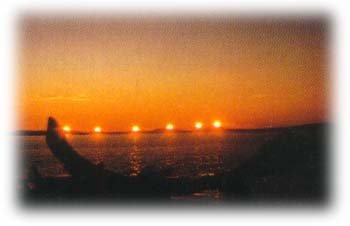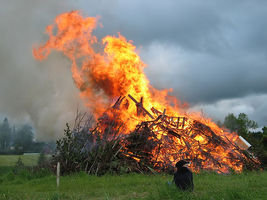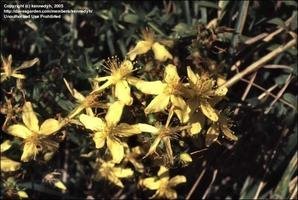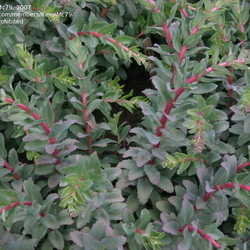





Today is the Summer Solstice in the Northern Hemisphere, the longest day of the year. It is also known in many places as Midsummer Day, although astronomically, it is only the beginning of summer.
(Editor's Note: This article was originally published on June 21, 2009. Your comments are welcome, but please be aware that authors of previously published articles may not be able to promptly respond to new questions or comments.)
There are many prehistoric sites that demonstrate how ancient humans were very much aware of the passage of the solar year. Among these are Stonehenge, where the photo shows the sunrise behind the Heel Stone on the morning of the Summer Solstice, and the Sun Dagger in Chaco Canyon, where a single glyph seems to mark the solstice and both equinoxes.
In many parts of the world, there seem to have been no significant traditional festivals to mark the Summer Solstice, unlike its winter counterpart. Upon consideration, this is not entirely surprising. The Summer Solstice does not mark any significant point in the agricultural year, either the beginning or the end of the growing season. In the regions near the Equator, the solstice is difficult to observe, and most ancient calendars depended more on the cycles of the moon or the stars to mark significant dates.
In Northern Europe, however, the Summer Solstice was definitely celebrated. In the regions above the Arctic Circle, this is the time of the Midnight Sun, when, instead of setting, the sun appears to hover around the horizon. The lengthy days at the height of summer make agriculture possible in regions where the growing season would otherwise be too short.
In the medieval period, the Summer Solstice, June 25 under the old Julian calendar, was one of the four Quarter Days, when debts were paid and rents were due. It was officially known, for reasons that are now not quite clear, as the Feast of St. John the Baptist, although this feast must have originally been dedicated to some other deity. It is otherwise known as Midsummer Day. Most of the celebrations of this event, however, took place the night before, on Midsummer Eve, which suggests a Celtic origin. The truth is "lost in the mists of time," which means that people had long ago forgotten exactly what they were celebrating, but celebrated anyway.
 The most common form of this celebration, which is still held in many places, is the lighting of bonfires, often including a ritual where the people leap over the fire and cattle are led between two fires. The early Christian church disapproved of the celebration as pagan and forbade the practice of leaping over bonfires and similar "solestitia," or solstice rites. The reasons given for these rites, however, are variable, as are the gods that the celebration was meant to honor. Bonfire celebrations were also held on the Celtic feast of Beltane, on May 1, and it is possible that there may have been some conflation of the two holidays. Maypoles, commonly thought to be fixtures of May Day festivals, are also seen at Midsummer feasts, particularly in Sweden.
The most common form of this celebration, which is still held in many places, is the lighting of bonfires, often including a ritual where the people leap over the fire and cattle are led between two fires. The early Christian church disapproved of the celebration as pagan and forbade the practice of leaping over bonfires and similar "solestitia," or solstice rites. The reasons given for these rites, however, are variable, as are the gods that the celebration was meant to honor. Bonfire celebrations were also held on the Celtic feast of Beltane, on May 1, and it is possible that there may have been some conflation of the two holidays. Maypoles, commonly thought to be fixtures of May Day festivals, are also seen at Midsummer feasts, particularly in Sweden.
A seventeenth century poem speaks of the multitude of Midsummer bonfires:
To see the aire appearing all on flame,
Kindled by thy bonfires, and from the same
A thousand sparkes disperst throughout the skie
There may have been a more sinister origin of the bonfires. Julius Caesar wrote of the Druids in Celtic lands such as Gaul conducting human sacrifice in which men were burned inside huge wicker cages made in human form. In medieval times it was common to hold similar animal sacrifices at Midsummer. In England, as late as the eighteenth century, there were also "giants" made of wicker that were paraded in the streets with torches at Midsummer, possibly a remnant of the original sacrifice.
It is not clear what gods were supposed to be the recipients of the sacrifice. The Celtic thunder god Taranis has been suggested. In Finland, the Midsummer festival was originally named for Ukko, also a thunder god. But on the Isle of Man, offerings are still made at Midsummer to the island's patron god Manannán mac Lir, a sea god.
The Midsummer feast is associated in Ireland with the goddess Áine, whose sphere was love and fertility, although some people have tried to claim her as a sun goddess to make more of the solstice connection. In many places, there is a strong suggestion that Midsummer was in fact a fertility festival, and the revelries on Midsummer Eve were condemned by the Church as licentious for this reason. Jumping through the bonfire, or leading animals through it, was supposed to confer fertility.
Another old poem refers to these revels:
As I walked out to yonder green,
One evening so fair;
All where the fair maids may be seen
Playing at the bonfire.
Hail! lovely nymphs, be not too coy,
But freely yield your charms;
Let love inspire with mirth and joy,
In Cupid's lovely arms.
Bright Luna spreads its light around,
The gallants for to cheer;
As they lay sporting on the ground,
At the fair June bonfire.
On the other hand, there are many traditions that the bonfires were meant as protection from supernatural evils, such as witches or fairies. Midsummer's Eve was one of the times that the fairies were supposed to come out and dance. This legend inspired Shakespeare's comedy, A Midsummer Night's Dream, with the rival fairy courts of Oberon and Titania.
In the Baltic countries, the solstice celebration is called Līdo, and it may have originally honored the sun goddess Saule. In Germany, it was called "sonnenwend," also after the sun goddess. In general, the rites were the same as in the Celtic counties, with bonfires and general revelry.
In Russia and the Slavic countries, the solstice feast is named Ivan Kupala Day. Ivan is the name John, and "Kupala" refers to water, suggesting the role of John the Baptist. But the original pre-Christian solstice feast may have once been called simply Kupala, involving the worship of sacred wells or other bodies of water, as well as fertility aspects of the celebration.
It was also a common belief in many places that certain plants had special powers if they were gathered on Midsummer Eve, preferably at the stroke of midnight. One of these was fern seed, about which there were several legends. One was that the ferns only had seed on this date, another that the seed was invisible, so it would give the finder the power of invisibility. Alternatively, it was an ingredient in the fairy ointment that allowed a mortal to see the otherwise invisible fairies. Ferns, of course, reproduce not by seeds but by spores, so small as to seem almost invisible.
 St John's Wort (Hypericum perforatum) was named for its association with this day. This plant is well-known to have
St John's Wort (Hypericum perforatum) was named for its association with this day. This plant is well-known to have medicinal properties. Another plant with solstice associations is Orpine (Sedum telephium), otherwise known as Midsummer Men. Both plants were often hung up at the doorway to repel evil forces, and orpine in particular was frequently used as a love charm; hung over the bed, it would cause a young woman to dream of the man she would marry. Other plants sometimes associated with this festival are Rue (Ruta graveolens) and Mugwort (Artemisia vulgaris). Since the same general properties are attributed to them all, it is likely that the original traditions have become confused.
medicinal properties. Another plant with solstice associations is Orpine (Sedum telephium), otherwise known as Midsummer Men. Both plants were often hung up at the doorway to repel evil forces, and orpine in particular was frequently used as a love charm; hung over the bed, it would cause a young woman to dream of the man she would marry. Other plants sometimes associated with this festival are Rue (Ruta graveolens) and Mugwort (Artemisia vulgaris). Since the same general properties are attributed to them all, it is likely that the original traditions have become confused.
Today, as more people become aware of the significance of ancient solar monuments and folk traditions, the Summer Solstice is being celebrated in many places in the world. People gather at such sites as Stonehenge or light bonfires as they watch and wait on the shortest night of the year for the sun to rise, just as, thousands of years ago, our distant ancestors once saw the first light of dawn on the longest day.
Reference: Brand, John. Antiquities of Great Britain, v 1.
Photo Credits:
Stonehenge: ©Andrew Dunn http://creativecommons.org/licenses/by-sa/2.0/
Midsummer bonfire in Finland: by Janna Karaste http://creativecommons.org/licenses/by-sa/2.0/
Midnight sun: Alaska Division of Tourism
St John's Wort: Plantfiles thanks to Kennedyh
Orpine: Plantfiles thanks to KevinMc79
Painting of fairies by William Blake
Copyright © www.100flowers.win Botanic Garden All Rights Reserved